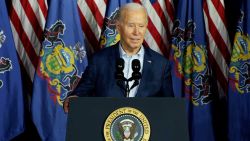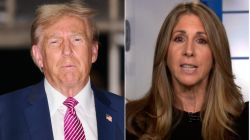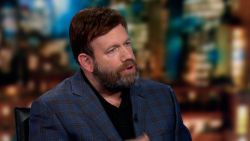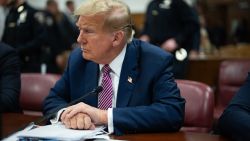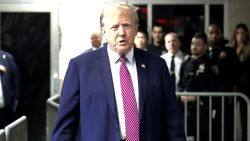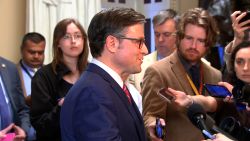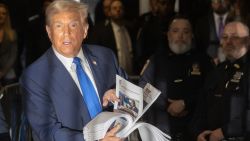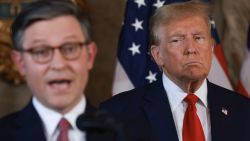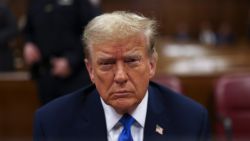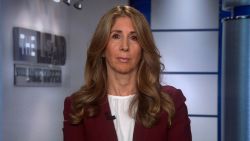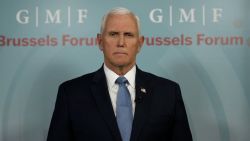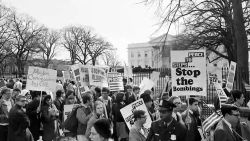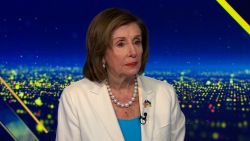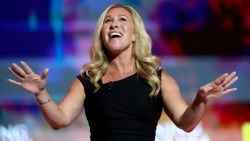On Monday, the percussive bang of flash grenades echoed in the Rose Garden and an acrid odor from chemical dispersant wafted over a presidential photo opportunity.
On Tuesday, the nation’s most prominent televangelist delivered his rebuke. The country’s senior-most military brass followed on Wednesday.
By Thursday, the White House began to resemble a fortress. And on Friday, President Donald Trump awoke to giant yellow letters painted on the street a block away from his home reminding him black lives matter.
The first week of June unfolded in historic bursts, five days of turmoil and tension the President watched unfold mostly from inside an ever-expanding buffer of security, its borders patrolled by a militarized police force and its resemblance to a wartime rampart striking.
The highly charged moment encapsulated the tensions of the Trump era, landing squarely at the intersection of authoritarian order and racial grievance. As Trump stretched the limits of executive power and fretted about appearing weak, his willingness and ability to address the civic, health and economic crises buckling the nation were deeply challenged.
Trump spent much of the week out of public view after a photo opportunity near St. John’s Church on Monday devolved into a violent, chemical-misted spectacle that was widely condemned and which prompted harsh internal recriminations for those responsible for its execution.
Behind the gates of an ever-more-fortified White House, Trump lashed out in the Oval Office at officials who appeared less-than-committed to his “law and order” approach and mostly ignored suggestions he at least attempt to unify a country ripping along racial and ideological seams. Instead, the President appeared to aides consumed by his worsening political prospects, fixated on how he was being portrayed on television and concerned by warnings from some of his allies that his response to nationwide protests conveyed weakness.
Determined to appear like a leader in command – and with images flashing through his mind of a stoic Winston Churchill surveying bombed-out London during the Blitz – Trump fixated on the nation’s capital city, which he came to regard as a test of his ability to quell unrest and provide security for an uneasy country.
He was irate when word of his retreat to the secure bunker five stories beneath the White House leaked, demanding to know who would have disclosed that information to the press. Later, he falsely claimed he was merely in the bunker to inspect it. Yet at moments over the past week, Trump has appeared shaken as protests – mostly peaceful but at times volatile – continued outside the White House.
When he emerged victorious on Friday following a shock jobs report showing 2.5 million payrolls added in May, Trump didn’t linger on the racial inequalities that have sent Americans to the streets in protest. Instead, he suggested George Floyd – the black man who whose killing in Minneapolis prompted a new national reckoning on race – would be happy about the current national status. The President has held no listening sessions with the black community or introduced any police reform proposals as protests have continued to grip the nation.
Enraged at the start of this week to discover he was being depicted cowering in an underground shelter, by Friday, Trump was living in a White House complex that had itself become a bunker – a 115-acre bulwark surrounding a President whose leadership and competence are reaching straining points by parallel crises of historic proportions.
Trump had intended to spend this weekend at his fenced private golf club in New Jersey as tens of thousands of protesters descend on Washington to demand action on systemic racism and police brutality but aides raised concerns about the optics of him golfing as protests were expected to continue.
Instead, he remains in an ever-more-militarized city, where what unfolded this week – both inside and outside his expanding protective bubble – may be remembered as among the most consequential in memory.
Monday

Even after a weekend of heated and violent clashes outside the executive mansion, on Monday morning the White House perimeter appeared normal.
When Trump arrived to the Oval Office midday, aides were already aware of his indignation over what, by then, was known simply as the “bunker story.” Highly attuned to his lifelong aversion to appearing weak, even those staffers who hadn’t spoken to him knew a report about his hour-long escape to an underground bunker would cause problems.
Those assumptions were confirmed when Trump unbraided aides and demanded to know from senior staff, including chief of staff Mark Meadows, communications adviser Hope Hicks and press secretary Kayleigh McEnany, who had leaked the information.
Moreover, Trump insisted on finding a way to reverse the impression he was cowering beneath the White House, silent and invisible, as the nation convulsed from protests that had in some places turned violent. First lady Melania Trump had been shaken by the ordeal, and opted to remain at the White House instead of leaving Washington for the planned space launch the next day, according to a person familiar with the situation.
Trump wasn’t seen on Sunday and spent most of Monday behind closed doors – leading to concern even from some of his allies that he was absent at a moment of national crisis. He had received blunt warnings from usual allies that he would lose the election in November if he didn’t immediately quell the violence happening across major US cities, including his own. Trump said he was being unfairly blamed for the situation, but the message seemed to break through. He began the day upset over the bunker coverage and determined to shift the narrative toward one of stamping out violence.
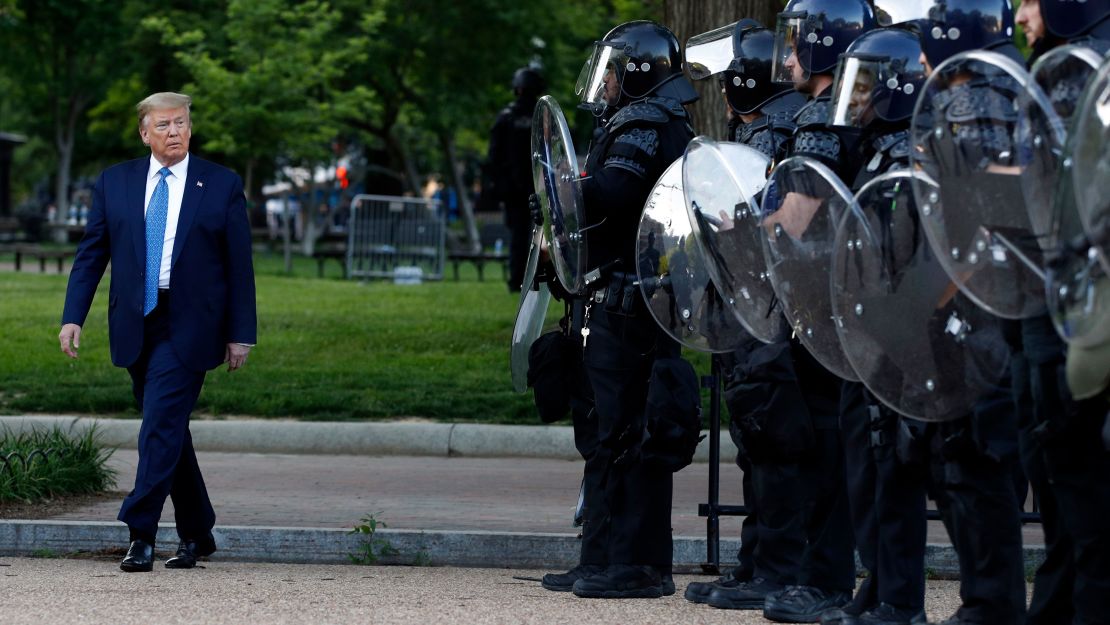
In a morning Oval Office meeting with top national security officials, Trump was presented with the option of invoking the Insurrection Act, an early 19th-century provision that would allow him to order active duty forces to tamp down on unrest. The idea appeared to some an overreach but others, including Vice President Mike Pence and Defense Secretary Mark Esper, seemed in favor. Others questioned whether the President was serious.
The meeting grew so intense that raised voices could be heard down the hallway from the Oval Office. In the same meeting, Trump repeatedly voiced concern that he appeared weak and unable to keep Americans safe from harm.
Though his press secretary had spent the better part of the morning arguing that another presidential address was not what the nation needed, Trump told aides he had decided to make one that evening.

The two issues – controlling violence and improving the optics – seemed to converge when Trump later raised the notion of emerging from the White House gates to walk to St. John’s Church, whose basement fire he’d seen covered the previous evening on cable news.
While it was Trump who came up with the idea of the church visit, Hicks and Meadows along with Trump’s son-in-law Jared Kushner and his daughter Ivanka Trump, were involved in the initial planning of the operation, according to two senior White House officials.
Outside the White House, Attorney General William Barr – who had participated in the earlier heated Oval Office meeting and was personally surveying the scene – was surprised to find Lafayette Square remained full of protesters, even though he’d ordered a wider perimeter around the White House following the weekend clashes.
As reporters were hastily assembled in the Rose Garden for brief remarks before Trump’s walk, Barr gave the order to clear the park – an operation that saw peaceful protesters dispersed with chemicals and flash bangs in a violent melee destined for history books.
Tuesday
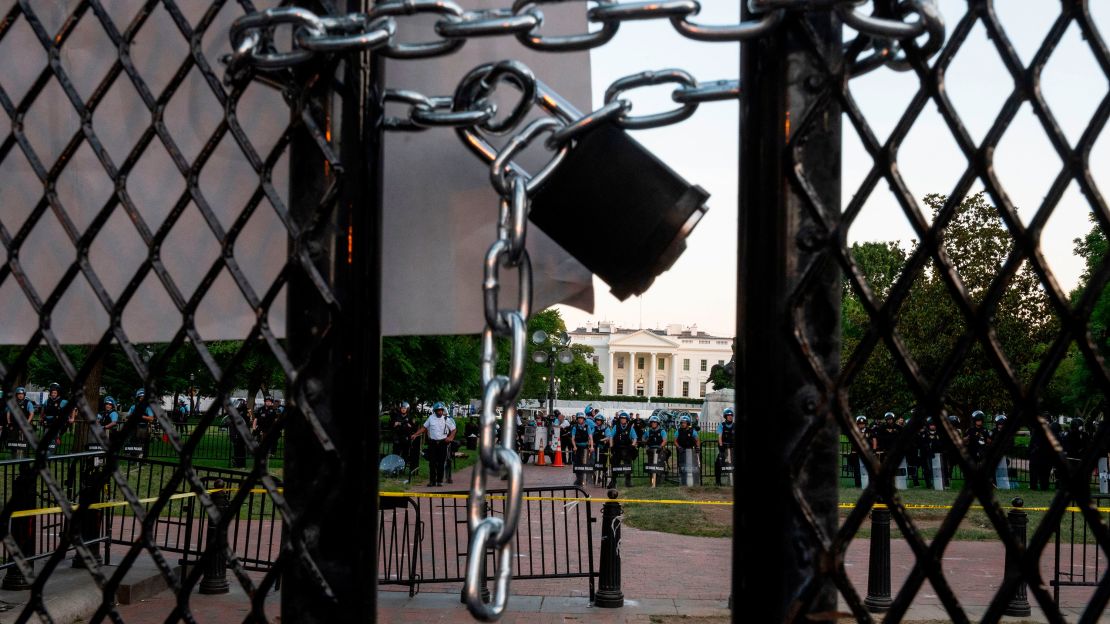
By the next morning, the 8-foot steel fences ordinarily used during inaugurations or world leader summits had been trucked in to fortify the White House. And White House aides were on the defensive about what had occurred the previous evening.
Trump himself seemed pleased with how the walk to St. John’s had proceeded and did not appear overly concerned at accusations he was drifting toward autocracy. He was insistent on putting forward a show of resolve, and was overheard telling his wife Melania – whose tweets supporting peace and healing have rankled some in the West Wing – to smile during a visit to a Catholic shrine.
Even the outing to the Saint John Paul II shrine became clouded in controversy when the Archbishop of Washington questioned why any Catholic facility would “allow itself to be so egregiously misused and manipulated in a fashion that violates our religious principles.”
As other critics of Monday’s mayhem emerged – ranging from the bishop who oversees St. John’s, who called the episode a “charade,” to South Carolina Sen. Tim Scott, the chamber’s only black Republican, who said tear gas shouldn’t have been used to clear protesters, to Pat Robertson, the prominent televangelist, who said “you just don’t do that” – some White House officials scrambled to engineer explanations for the incident.
The White House insisted the decision to clear protesters from the park was unrelated to Trump’s decision to walk from the White House to the church, claiming Barr had already decided to expand the security perimeter hours before a 7 p.m. ET curfew mandated by Washington’s mayor. Trump questioned why the removal tactics were being criticized, given the protests had turned violent the night before.
And after extensive discussion between various administration entities – including the White House, the Secret Service, and the Departments of Justice and Interior – the US Park Police released a statement denying its officers used tear gas to disperse protesters from Lafayette Park, insisting instead they’d used “pepper balls.”
That the US government defines “pepper balls” as a type of tear gas did not appear to dampen the administration’s efforts to paint media coverage of the incident as skewed and Democrats as pro-violence.
More from CNN Politics
Still, the incident on Monday caused some private concerns internally that Trump had taken a desire to project “law and order” authority too far. The hurried logistical efforts that went into the 17-minute walk seemed to many officials half-baked, particularly the apparent lack of a plan for what Trump would do when he arrived outside the yellow Greek Revival church. Instead of bowing his head in prayer or speaking with church officials, who had no idea he was coming, Trump awkwardly held up a bible his daughter carried over in her designer handbag.
Also concerning to some aides was the lack of any racial diversity in the group which accompanied the President on his walk, despite the issues of racial injustice that underpin the current civic unrest.
The President has only a few senior African American advisers and his sole black Cabinet member, Housing and Urban Development Secretary Ben Carson, was not present, though Trump and Carson spoke by phone earlier Monday. Aides later admitted that was a visual mistake.
While some White House officials had begun preliminary steps toward arranging a “listening session” with black leaders at the start of the week, such an event never materialized – at least for Trump. Vice President Mike Pence participated in such a panel on Friday.
The President, meanwhile, has not addressed at length the issues of racial inequity that other American leaders – from the corporate world to academia to all four of his living presidential predecessors – are now wrestling with publicly.
Wednesday
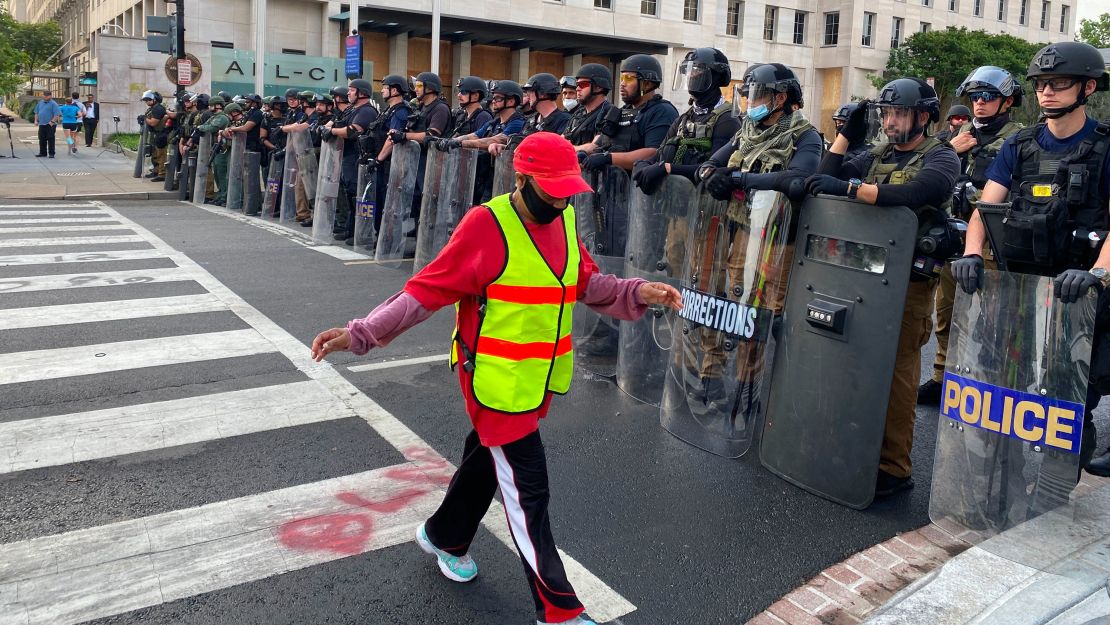
As the week wore on, the perimeter surrounding the White House was grew. Ranks of law enforcement officials – some of whom refused to identify their agency – stood sentry carrying riot gear.
Inside the gates, officials were aware that Defense Secretary Mark Esper – who’d been at the White House for meetings earlier in the week and did not appear at great odds with the President – would be convening a news conference at the Pentagon.
But they were unprepared for what he would say. Esper distanced himself from the maligned photo-op outside St. John’s and said he did not support using the Insurrection Act to allow active duty troops to quell the large scale protests, even though Trump had insisted he was open to using that option on Monday.
His comments landed with a thud in a West Wing already contending with widespread condemnation of the church visit.
“No idea who thought that was a good idea,” one official said.
Other officials were puzzled at Esper’s proclaimed ignorance of where he and other aides were headed when they exited the White House on Monday evening, since it was clear to everyone else in the building that the church was their destination.
For months, the President and national security adviser Robert O’Brien had been losing faith in Esper’s ability to lead the military and his tendency to avoid offering a full-throated defense of the President or his policies, according to multiple administration officials.
O’Brien, in particular, has spoken to the President about Esper’s television remarks, which the White House has viewed on repeated occasions as problematic or off-message. On at least one occasion, O’Brien presented the President with print-outs that compare his own public remarks on a topic to those of Esper to highlight the contrast. Trump had even mused about a new defense secretary during a recent weekend at Camp David.
Shortly after concluding his Pentagon news conference, Esper arrived to the White House for a meeting with Trump, where the President reprimanded his defense chief for speaking out and appearing to contradict him.
Trump was convinced by aides that firing Esper would be poorly timed and a major distraction as other crises swirl. But officials were not optimistic about Esper’s eventual fate within the administration, suggesting Trump had grown tired of his Pentagon chief. At a midday briefing, McEnany declined to boost Esper’s standing.
“If he loses confidence in Secretary Esper, I’m sure you all will be the first to know,” she said.
But it turned out Esper was only the beginning. A few hours later, his predecessor at the Pentagon, Gen. James Mattis, issued a statement excoriating Trump’s “bizarre” photo op outside the church and declaring his former boss “the first president in my lifetime who does not try to unite the American people – does not even pretend to try.”
“We are witnessing the consequences of three years without mature leadership,” the onetime defense secretary wrote.
Trump had long soured on Mattis. But the wave of military brass who seemed to be undermining him on Wednesday – which also included Adm. Mike Mullen, the former chairman of the Joint Chiefs of Staff, and Gen. John Allen, the former anti-ISIS envoy – made for a striking picture, particularly for a President enamored with militaristic pageantry who touted a roster of generals at the start of his administration.
“Probably the only thing Barack Obama & I have in common is that we both had the honor of firing Jim Mattis, the world’s most overrated General,” Trump tweeted, even though Mattis quit the administration in protest.
What Mattis said publicly was something he and other former top aides have said privately about Trump for some time, according to multiple people. The President had even remarked to aides before that Mattis wouldn’t go after him, noting he wrote in the introduction to his book, “I’m old fashioned: I don’t write about sitting presidents.”
But sources close to Mattis described a man who had reached a breaking point.
Thursday
As reporters arrived to the White House early Thursday, more steel fences and concrete barriers were arriving on flatbed trucks. The fortification was expanding, even as White House officials insisted it was merely for security purposes and that Trump hadn’t ordered it himself.
Behind the ramparts, the President’s political aides were arriving for a regularly scheduled session to discuss his reelection bid, which has been scrambled by a mismanaged health crisis, the ensuing economic disaster and now civic unrest.
Campaign manager Brad Parscale, deputy campaign manager Bill Stepien, pollster Tony Fabrizio, Kushner and Meadows met with Trump to discuss both the campaign and a recent spate of battleground polling, which shows Trump at arguably the most politically perilous moment of his first term.
Aides say Trump has appeared fixated on his political woes for the past several months as his handling of the coronavirus pandemic earned him poor marks, particularly with elderly voters. Trump has watched with both anger and confusion as his rival, Vice President Joe Biden, reliably bests him in head-to-head polling.
In public, Trump has discounted surveys showing Biden ahead and is quick to remind his followers on Twitter that pundits and polls turned out to be wrong in 2016. But his unease over the current political environment has been palpable at the White House, where Trump has repeatedly asked why more isn’t being done to improve his standing.
In an apparent effort to combat those political woes, the Trump campaign and the Republican National Committee announced on Thursday that they will resume in-person campaign efforts next week, returning Republican field organizers who have been working from home since March to key states.
And Trump himself plans a return to in-person political fundraising next week when he’ll travel to Texas for a high-dollar event.
But the marquee political event of the summer, Trump’s nominating convention in Charlotte, seemed to fall apart this week when North Carolina’s Democratic governor demanded party leaders provide him plans for a scaled-down event.
The battle over the convention has infuriated the President, who does not believe delegates should be socially distanced and has bristled at the thought of a convention hall full of people wearing masks.
Itching for a return to campaign rallies, the President has asked privately when he can again begin traveling to key states, where he believes his events will help bolster his standing in polls.
Friday
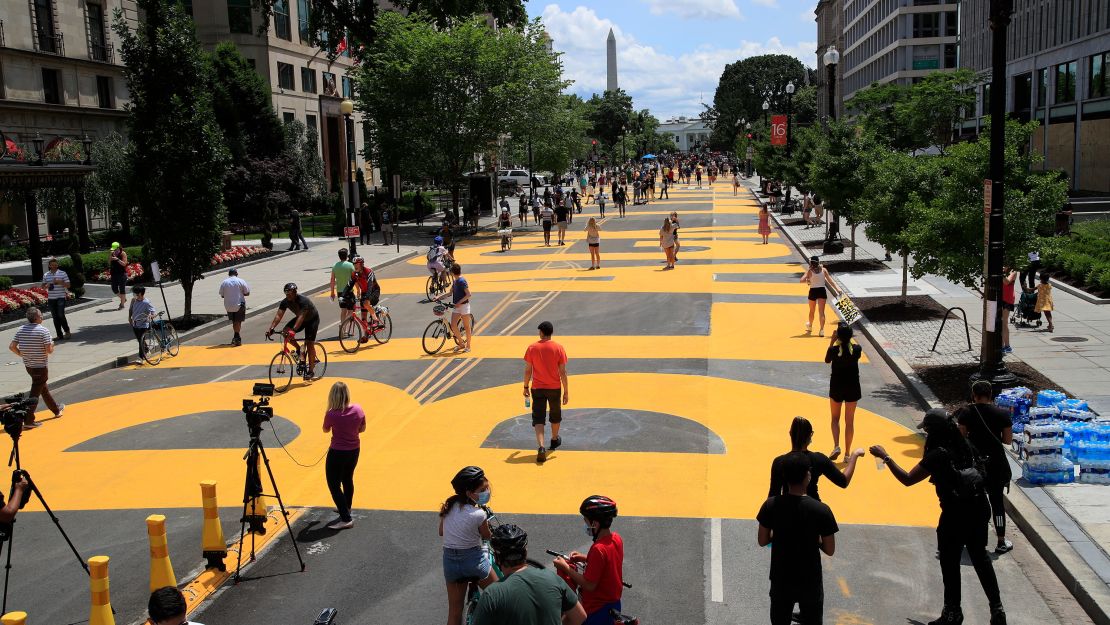
As the week concluded, a final block of fencing had been erected to complete the new protective barrier around the White House as a weekend protest loomed. Even as several hundred members of the 82nd Airborne Division infantry battalion began returning home to North Carolina after positioning outside Washington, the city remained in a heightened militarized state.
Trump had once hoped to escape the city for his golf resort in New Jersey; he’s avoided weekending at any of his properties since the coronavirus pandemic halted travel. But aides warned that returning to Bedminster could risk another weekend where Trump appeared absent in the midst of a crisis.
The national guardsmen, Bureau of Prisons officers, US Marshals, Drug Enforcement Agency agents and a host of other acronym’d forces patrolling Washington streets – ordered up by Trump’s empowered attorney general William Barr – have drawn consternation from the city’s Democratic mayor.
So has the ever-increasing security surrounding the White House, which past presidents have sought to keep as open as possible even amid national emergencies.
“It’s a sad commentary that the house and its inhabitants have to be walled off,” Mayor Murial Bowser said this week. “We should want the White House to be opened up for people to be able to access it from all sides.”
On Friday, in the early morning hours, Bowser had city work crews paint the words “black lives matter” in giant yellow letters along the stretch of 16th Street closest to the White House, yards from where Trump stood Monday outside St. John’s Church.
Inside the White House, aides had been bracing for another dire jobs report as the economic downturn caused by the coronavirus pandemic persists. But, unexpectedly, the report was positive. And a wave of relief washed over Trump’s campaign aides and political advisers, who had grown increasingly worried that the grim state of the economy is imperiling Trump’s reelection prospects.
Asked how relieved they are about the jobs report on a scale of 1 to 10, a source close to the campaign replied: “11.”
Returning to the Rose Garden four days after an appearance backed by the sound of flash bangs, Trump seemed ready to move on: from the racial unrest, from the coronavirus pandemic and from the economic devastation that has still left millions of Americans out of work.
Chairs for reporters that were once spaced out to allow for social distancing were jammed together because it “looked better.” The woes of Americans who have lost loved ones to coronavirus went unmentioned.
And the underlying issues of racial injustice and police brutality that prompted cries of anguish across a divided nation unlike anything in decades received a few words, recited from a note card.
“Equal justice under the law must mean that every American receives equal treatment in every encounter with law enforcement, regardless of race, color, gender or creed. They have to receive fair treatment from law enforcement. They have to receive it,” Trump said.
“We all saw what happened last week. We can’t let that happen,” he went on. “Hopefully George is looking down right now and saying, ‘There’s a great thing that’s happening for our country.’ This is a great day for him, it’s a great day for everybody.”
CNN’s Jeremy Diamond and Betsy Klein contributed to this report.




